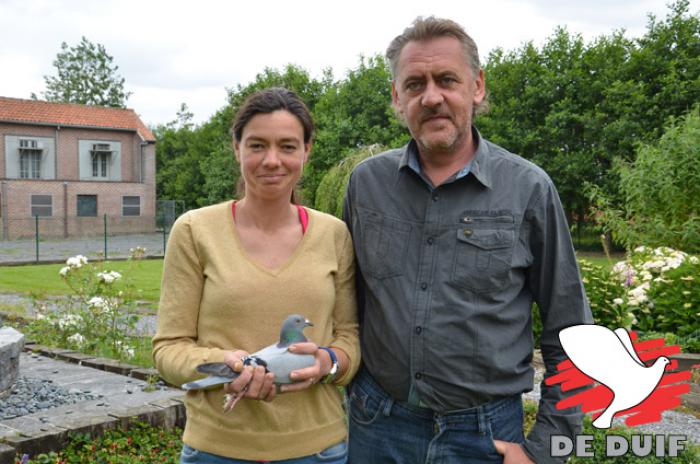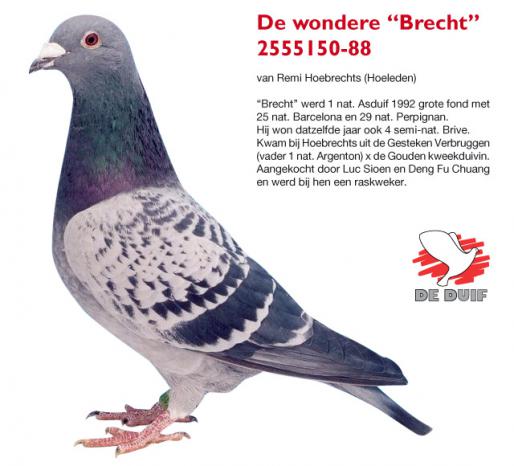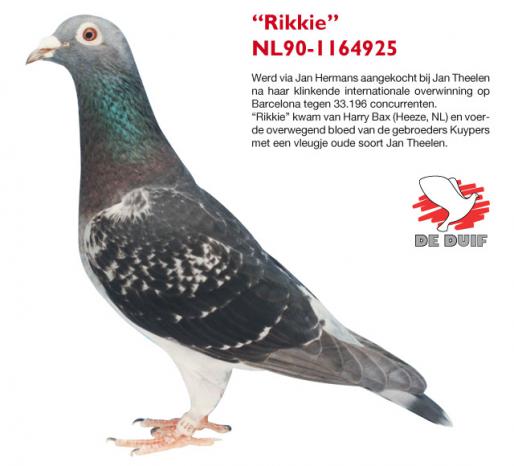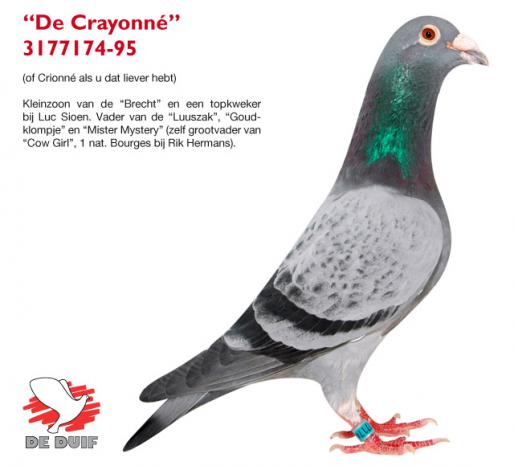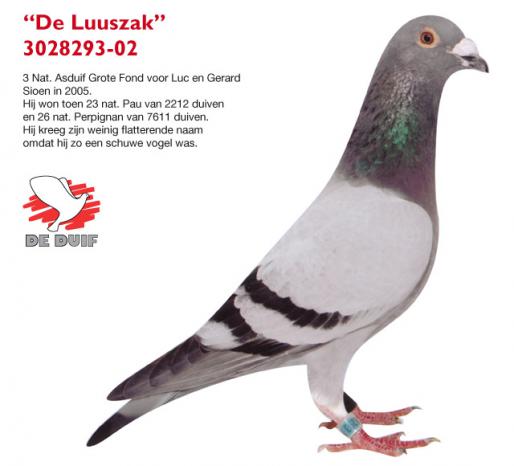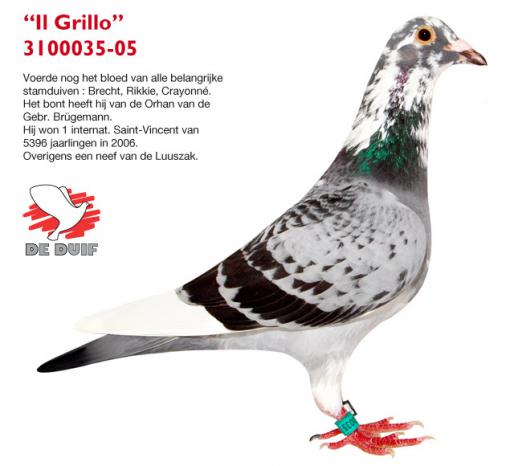Liefhebber:
Onderwerp:
PART I: The eventful pigeon career of Luc Sioen
Hilde who? I hear you asking. Indeed, Hilde is usually mentioned in the same breath as her husband Luc Sioen. But although she doesn’t race under her own name, we can certainly add her full name to the chronicles of the pigeon sport as someone who has ‘it’ in the fingers. Otherwise you wouldn’t win five big nationals under your own steam, otherwise you wouldn’t ‘park’ six pigeons in the first seven national out of La Souterraine over the three categories. “Hilde can do things with the pigeons that I can’t,” Luc Sioen modestly confesses. Luc himself may have won international St. Vincent with the ‘Il Grillo’, but “Hilde has a special connection with her pigeons”, Luc continues, “The pigeons like her, they are happy when she comes into the loft, and I’m sure that it’s her the birds fly home for...” Hilde Vanoverschelde is a natural, that much is clear. But first we want to tell you the story of her husband Luc Sioen.
Gerard Sioen
We can’t tell the pigeon story of Luc Sioen without telling the story of his father Gerard as well. Gerard, who died in 2007, had been one of the best pigeon fanciers of the area for most of his life. All this time, he stayed true to the speed races, with a little bit of middle-distance for good measure, and he stayed true to his principles: pigeon racing of the last century you could call it. Gerard only kept a few pigeons, had a razor sharp knife and went almost never to a vet. But he had good quality pigeons, and to these he also stayed true for his entire life. These pigeons were not necessary big names, but they were all-rounders. Luc tells us: “I always had other pigeons, but once in a while I added a few of my father’s birds, and these could always race long-distance with ease. They were strong pigeons”. “Was there also a touch of Bostyn in these?” I wanted to know. “No,” Luc resolutely answered, “Bostyn is a completely different story.” Most readers will undoubtedly know that the late Pol Bostyn was also a resident of Moorslede. “Bostyn lived barely half a kilometer from us,” Luc told us, “but father knew him more from the flax cultivation than from the pigeons. You must know: Pol Bostyn, was Champions League, long-distance and extra long-distance, while my dad played more in the ‘second division provincial’ team. So in pigeon racing, their paths almost never crossed.”
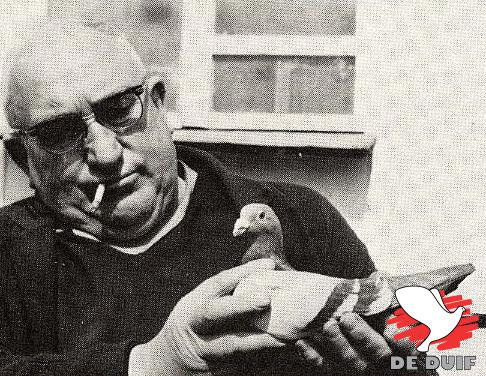
At the time that Luc Sioen as young man met Pol Bostyn, Pol was already on the way out. This didn’t preclude Bostyn from making a great impression on Luc Sioen, who justly calls him an ‘important figure’ in his life...
Even so Pol Bostyn
Luc Sioen has had the pigeon bug from very early on. As a young boy of ten or eleven years old, he was sometimes allowed to accompany his father, and of course he got some attention from the other club members. In 1977 for instance, a friend of his father’s gave him a young pigeon. Normally, that pigeon would go into the loft with the other young pigeons, but Gerard and Luc thought otherwise: it was a pigeon for Luc, and therefore Luc would look after it himself. He was given the use of a very small compartment, and the pigeon was trained. And you can guess what happened: it became a super pigeon and straight away it flew first in the speed races twice in a row. “Yes, that’s when you are hooked for life of course,” Luc sighs with a broad smile. But we were talking about Bostyn.
One day, a strange young bird sat among Luc’s small team. “Nowadays, I would chase that bird out as quickly as possible, but as a boy of eleven, you find that interesting and a challenge to tempt it into the loft.” Father Gerard had a look at the bird, saw that it was good quality and according to its ring number, it couldn’t have come from far away. They reported the pigeon and two days later they found a ‘yellow postcard’ -that’s how it was done then- in the post. The pigeon belonged to Pol Bostyn and he came to collect it at once. Pol, the tough man with a gentle heart, immediately liked the young Luc Sioen and invited him to come look at his pigeons. Luc didn’t have to be asked twice because even during his life Bostyn was already a legend in the Belgian pigeon history, which even the young Luc knew.
A few years too late
Luc muses a bit more about that period, and says with regret that it was actually a few years too late when he met Bostyn: the man, the fancier, and the pigeons were past their best at that time. To say it gently, Bostyn was in decline. But as people, the old Bostyn and the young Luc Sioen liked each other. It started with ‘watching’ when the pigeons had to come home from a big race a few times, but very quickly, Luc was drafted into helping: catching pigeons, basketing pigeons, noting down the numbers of the racers, taking hens from the nest... “In the end, I was there almost every day,” Luc said. “I even dared to play truant at school sometimes, because I would much rather be with the pigeons than go to school. I was studying for at the time a very new course, computer control for machines (CNC), but I didn’t like studying, and I never did anything with the diploma I got in the end. Also, I was not very good with ‘authority for the sake of authority’ and that is still the same,” confesses the spirited Sioen. Just to say that he was practically living with Bostyn and that he couldn’t do wrong for the sometimes crazy Bostyn.
Learned little or...?
“So that is where you learned about the pigeon sport?” I ask almost rhetorically. “Not by a long chalk,” Luc contradicts. “Pol was unfortunately past it, not motivated at all anymore... also the pigeons were worn out and actually chronically ill... The only thing that still counted was to receive the many visitors, and sometimes they came by the busload and give them a tour of the world renowned loft, and to breed the pigeons for sale, because that was still ongoing. For that matter, that was one of the aspects that I found interesting: many big names came visiting, and agents and foreign fanciers, and that’s how I came to know the network of big names. But the finer aspects of the pigeon sport I have learned more from my father than from Bostyn. Mind you, I keep regarding Bostyn as one of the greatest champions in Belgium, and as a specialist of the better pigeon he was almost unequalled. But I was ten years too late to see the star Bostyn at work.” The genes of the Benoni’s, Coppi’s, Pasports, Mustangs and Chico’s were still very much notable, but the quality didn’t show anymore, at least not with Bostyn himself. But after the glorious Seventies, his pigeons were still more than ever sought-after in Belgium, and even more so abroad. The Bostyn loft was turning into a breeding station, and Pol started to keep more pigeons than he could handle. But performing well, let alone winning, was almost non-existent. “That is one thing I learned there,” Luc Sioen says: “When you start to couple and breed for commerce, then you go downhill faster than the cyclists in the Tour de France. In his heyday, Bostyn was a ruthless selector, but when commerce started to get the upper hand, it was only seldom that pigeon was on the menu in the household of Bostyn...”
What’s more, the breeding installations of Bostyn were actually unsuitable; he had housed his mass of breeders in the barn, where it was always damp. “But I also learned something else there,” Luc says resolutely. “In among all that misery -excuse the word, but that’s what it was- Pol Bostyn still had one better pigeon, and that was the ‘Lourdes’. When the rest of the colony (Bostyn still had some 100 widowers!) was done for, that pigeon came through time and again. Which has led me to the conclusion that a fancier mustn’t complain about ‘my loft this and that, the form this and that, the health this and that, the pigeon feed this and that...’ if you have a star in the loft, he will show himself. This has made me decide for myself: first seek out the good pigeon, what I am saying, the top pigeon. And that pigeon will then tell you if the loft or the care can be improved. Or in yet other words: only keep the good ones, because if you lose the selection, success is also lost. It’s as simple as that.” “But...,” Luc states again to close the chapter: “Until today, I still carry a torch for Pol Bostyn. In his own way, he was a very influential figure in my youth and in my pigeon fancier career.”
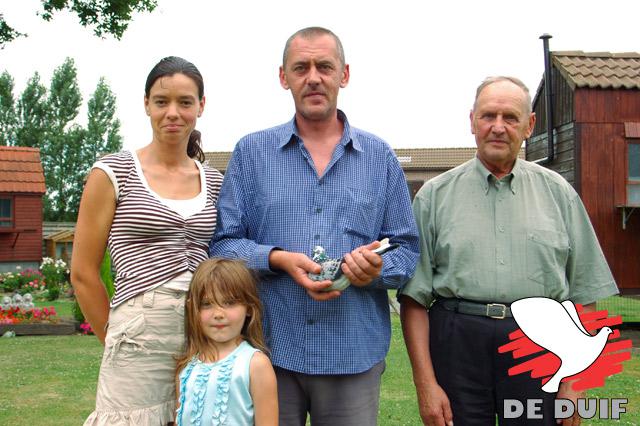
From right to left: Gerard and Luc Sioen, together with Hilde and daughter Indra.
To the long-distance
Pol Bostyn died in 1985 and his pigeons were dispersed all over the world. The end of an era, also for Luc Sioen. Luc returned after his military service and started to race together with his father. Luc wished to take up long-distance racing and Gerard let him do what he wanted. They bought some pigeons from Herman Callebert, but -we already mentioned it before- father Sioen’s own breed performed very well on the long-distance as well. In the meantime, Luc still kept up his network of Belgian and foreign contacts, and through these, he sometimes acted as middleman in transactions of pigeons to other countries. One of the contacts that he still had from his time with Bostyn was the Taiwanese Deng Fu Chuang. Deng Fu was an ambitious businessman who planned to start racing in Belgium, and preferably to achieve world famous results from Barcelona. He knew the young Sioen and discussed his plans with him. Money was apparently no problem for Deng Fu Chuang, and he wanted nothing but the very best. Together they would storm the international podium of Barcelona...
Great Wall
In 1992 it was a fact: the combination Deng Fu Chuang & Luc Sioen was a reality under the nice sounding name of ‘International Lofts Great Wall’. A gigantic loft was built on the premises of the family Sioen: a brickwork loft with two stories, about 35 meters long with 10 spacious racing compartments. There was space enough since the flax production was ended and the barns and the flax factory had been demolished. The only things still missing were the pigeons.
Once again, Luc Sioen’s good contacts in the pigeon world proved very useful. The duo wanted nothing but the very best pigeons in their loft, which meant national and even better international winners, national ace pigeons or pigeons that were of world class otherwise. It would be too much to name all the pigeons that passed by, but there were a great many of them.
A selection:
- ‘Speeltie’, DV8759-291-90, 1st international Pau against 6,875 pigeons in 1992 for Klaus Schmitt. And they bought the parents as well...
- ‘Margriet’, DV6055-200-87, 1st international Pau against 5,927 pigeons in 1990
- ‘Barcelona Brasse’, NL2012144-89, 3rd international Barcelona against 27,108 pigeons in 1992, + his nest sister and his parents, and in the end the entire loft Brasse (mainly Stichelbaut and Van der Wegen)
- ‘Cobbe’, NL2842534-91, 1st national Dax against 36,861 pigeons in 1992 for John Crombach, Kerkrade
- ‘Commer’, 3210906-85, 2nd international Barcelona against 21,736 pigeons in 1987 for Gerard Decommere
- ‘Bardinos’, NL1052186-88, 1st national Ace pigeon long-distance NPO in 1990 and Olympiad Verona
- ‘Tonsing’, NL5747846-87, 1st national Ace pigeon long-distance NPO in 1989, 3rd national Perpignan for Jan Cobben
- ‘Tiger’, NL1108985-87, 2nd national Ace pigeon long-distance NPO in 1991, 3rd national Bergerac
- ‘Brecht’, 2555150-88,1st national Ace pigeon from Remi Hoebrechts with 4th semi national Brive against 1,909 pigeons, 25th national Barcelona against 11,399 pigeons and 29th national Perpignan against 6,103 pigeons, all in 1992
- Children out of ‘Orhan’ and ‘Myra’, the very best of the Brugemann Bros from Assendelft
- And of course ‘Rikkie’, NL1164925-90, 1st international Barcelona against 33,196 pigeons in 1993 from Jan Theelen.
Contrary to what you might think, dear reader, it was not their intention to create a luxury breeding station. The intention was in the first place sporting: excelling on the hardest distances. For Deng Fu it was also a matter of prestige. With (photographs of) these pigeons and that installation you can easily impress friends and competitors at home. Now the results only had to start rolling in...
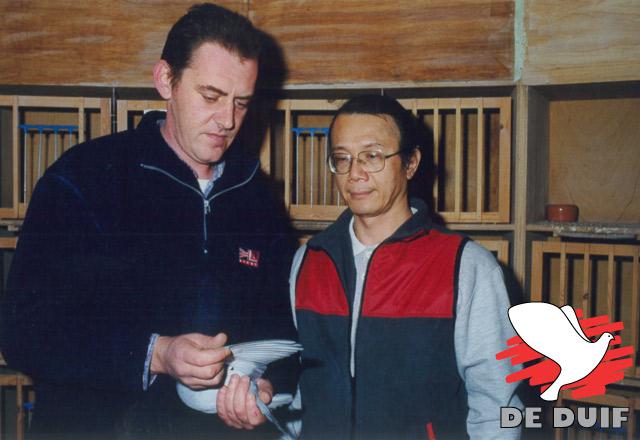 |
|
Luc Sioen with his Taiwanese partner Deng Fu Chuang. Together, they form the International Lofts Great Wall in Moorslede in 1992. The lofts were populated with the very best pigeons of the time...
Good but not good enough
Because their goal was the extra long-distance they had to practice patience for a few years, and it was only in 1995 that they could start seriously with a team of second-year pigeons. The results were there, but actually not so overwhelming as hoped and dreamed of beforehand. They had good results with all that illustrious power: on a regular basis top 20 or top 30 national, twice with the national champions KBDB extra long-distance (among others 8th national Champion long-distance in 1998), 4th in the West European Super Marathon, 7th European Champion ZLU and a few other nice classifications. For instance the ‘Broere’, ring number 3121305-93, a son of ‘Brecht’, became 8th international ace pigeon Barcelona for four years (1995-1998) and in 2000, 6th Primus inter Pares BBC and so on. But nevertheless, both Luc Sioen and his Taiwanese partner were not entirely satisfied. After all the results were not so spectacular that they stormed the national and international podiums: good but not good enough. It was a bit like our Belgian football team: a collection of world-class superstars but who are not achieving the amazing results that everybody hoped for... “I have thought about this a lot, or rather, worried about it... I lay awake at night over it..., searched for an explanation,” sighs Luc Sioen. “We have pampered these pigeons, looked after them and given them every chance, but I actually suspect that those breeding pigeons had never really felt happy with us. Call it the famous tree that you had better not uproot. After all, you move top pigeons hundreds of kilometers from their home, and put them in aviaries and breeding boxes. Wouldn’t you fret and pine for home yourself? I think that this has certainly been a factor that prevented the breeding form here...” And Luc substantiates this with a remarkable story: When Hein Brasse once visited us and went to say goodbye to his famous ‘Barcelona’, the bird started cooing and turning in its box... something he hadn’t done before at all in Moorslede. “The conclusion was clear,” Luc decides, “It isn’t enough to buy the best pigeons in the world and to put them all together to breed equally good winners out of them... Pigeon sport is not simply a mathematical equation...”
Balance
After 10 years ‘International Lofts Great Wall’, the partners Luc Sioen and Deng Fu Chuang got together to make up the balance. In the end, only the ‘Rikkie’ and the ‘Brecht’ had achieved what they were bought for. For their own loft, the ‘Rik’ (3177088-95), a son of Brecht x Rikkie, flew 19th national Barcelona against 12,731 pigeons in 1997. The ‘Usie’, a hen out of brother Rik x daughter Tonsing won 1st national Pau hens in 1997 (6th international hens of 1,260 pigeons). That seemed like a good start, but the euphoria was short-lived. The combination Sioen-Deng Fu Chuang was certainly strong competitors, but they had not really realized the high set goals of 1992. And in the end, they decided to end their partnership on friendly terms. “I didn’t want to discuss and haggle a lot about who would keep what, and suggested that Deng Fu would keep all racers and breeders. Deng Fu had obviously nothing against this proposal, and the birds were moved to Taiwan. After this they didn’t have much contact and Luc Sioen doesn’t know what has become of these super pigeons. He had kept a small core of young out of the superstars for himself, and there were still a number of descendants of especially the ‘Brecht’ and the ‘Rikkie’ in the lofts of friends.
However, don’t think that there were no pigeons at Sioen’s home at all... During the entire period, Gerard Sioen had kept his own pigeons and been racing his own races with these. So Luc could effortlessly step back into the combination with his father. And -even more important- in the meantime Hilde had come on the scene and she had become a fancier herself, with her own loft from where she raced with young pigeons and hens. But that is another story that will be told in PART II.
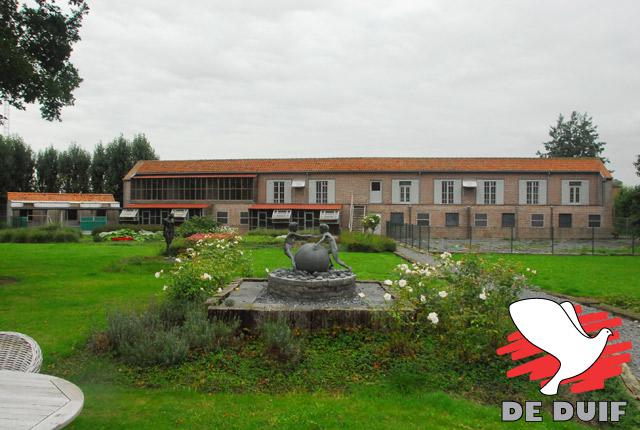
The impressive lofts from where the combination Sioen-Deng Fu Chuang would storm the international long-distance podiums.
The Luuszak
One of the better pigeons from Gerard and Luc Sioen in the ‘post Great Wall period’ was the ‘Luuszak’, 3028293-02. He was a son of the ‘Crayonne’ (in the pedigree altered into ‘Crionne’), 3177174-95, a grandson of the ‘Brecht’. The ‘Luuszak’ flew among others:
- 23rd national Pau against 2,212 pigeons in 2005
- 26th national Perpignan against 7,611 pigeons in 2005
- 30th national Pau in 2007
- 147th national Perpignan in 2006
By way of his father ‘Crayonne’, the ‘Luuszak’ is also half-brother of the ‘Goudklompje’, mother of ‘Il Grillo’, 1st international St. Vincent 2006 and grandmother of the ‘Fabian’. This ‘Fabian’, 3113064-06, won 1st provincial St. Vincent against 1,297 yearlings and 3rd international St. Vincent in 2007. The ‘Fabian’ was an inbred: his father ‘Fabio’ was a brother of the ‘Il Grillo’ and his mother ‘Wilma’ was a daughter of the ‘Crayonne’, and so half-sister of the ‘Luuszak’ and ‘Goudklompje’...
The ‘Crayonne’ himself flew in his active career:
- 91st national Montauban
- 97th national Pau
- 95th national Narbonne
The mother of the ‘Luuszak’ was the 3025047-99, who won 9th national Argenton in 2000. This Argenton hen came out of the 8th national Bourges 1998 (Decroix x Verheye) x daughter Generaal (1st national Cahors 1996 for Georges Bolle).
A bit of the history of a name
But where did that unusual name ‘Luuszak’ come from? ‘Luuszak’ is West Flemish for fleabag: a very unkempt person and therefore carrier of pests. There is also an interpretation of ‘lazybones’, but in my opinion this is wrongly derived from ‘lazy’ instead of ‘flea’. But when someone in the area of Roeselare calls you ‘a luuszak’ -and it isn’t said in jest- then I would not feel that as a compliment. It would have a meaning like, ‘good for nothing’, ‘vagabond’ or something. For that matter, that is also the description of this pigeon: an insufferable, wayward pigeon that rubs you up the wrong way, a bad pigeon. “The ‘Luuszak’ was an extremely shy bird,” Luc explains, “He could stay outside the whole day, just because he was afraid to drop down and come inside. Basically, a pigeon that could drive you insane on a day like that... but he was a super pigeon. With all his dithering and hesitation, he still managed to become 3rd national ace pigeon long-distance...”
Fundamental error
Luc Sioen couldn’t have had a better pigeon than the ‘Luuszak’: he achieved high results on a regular basis and he had a super pedigree... And thus Luc developed a complete breeding program around the ‘Luuszak’ and his father the ‘Crayonne’. He dreamed of a close pigeon family, his own pigeon breed with the famous ‘Luuszak’ as a base pigeon. And basically that worked out fairly well. The only thing that Luc had underestimated was that the shyness of the ‘Luuszak’ would be genetically defined and would be inherited for generations. “Within a few years I had a whole colony of pigeons that didn’t conform. I want to spare you the stories of the times that I didn’t have a single pigeon back in the loft because they were too shy to drop down and enter the loft -God knows why- and that they unsettled the rest of the colony by their flapping around over the roof... It drove me insane...” There will come a time that Luc Sioen will make a stone of his heart and dispose of the complete ‘Luuszak family’: racers and breeders. Luc Sioen doesn’t like half measures...
Meanwhile
But in among all these unruly pigeons, there was still one super, the ‘Il Grillo’ (Italian for cricket and also the nickname of Paolo Bettini, who won the cycling world title in 2006), with ring number 3100035-05. In that same year 2006 the ‘Il Grillo’, and with him Luc Sioen, made the front page of the pigeon magazines by winning 1st international St. Vincent against 5,396 yearlings with two hours in the lead. The ‘Il Grillo’ was a grandson of the ‘Crayonne’ and therefore a nephew of the ‘Luuszak’. His mother was in fact a daughter of the ‘Crayonne’, coupled with a cock out of the loft from Hilde, who won 1st national La Souterraine in 1999. We will come back to that later. The father of the ‘Il Grillo’ had in him all the best of what remained of the Great Wall period, in particular the ‘Orhan 66’. This ‘Orhan 66’ came out of the ‘Rik’ (19th national Barcelona and before mentioned son Rikkie x Brecht) x a daughter of the ‘Orhan’ from the Brugemann Bros.
The offspring
All in all the offspring of ‘Brecht’ and ‘Rikkie’ was positive. For instance the ‘Brecht’ gave a few absolute toppers in following generations:
- 1st national Pau hens in 1997 (in their own loft with the ‘Usie’, granddaughter ‘Brecht’, ‘Rikkie’ and ‘Tonsing’)
- 1st international Dax 2006 (for D & D Platteeuw in Zillebeke)
- 1st international St. Vincent 2006 (before mentioned ‘Il Grillo’ for Luc Sioen himself)
- 1st national Barcelona 2005 (‘Queen Tonny’ for Bungeneers). The ‘Queen Tonny’ from Frans Bungeneers was a half Sioen, still from the period with Deng Fu.
Mother of ‘Queen Tonny’ was a heavily inbred granddaughter of the ‘Brecht’. Which came about like this: In 1993, at the purchase of ‘Rikkie’, Luc had made firm contact with Jan Hermans, who in fact had bought the ‘Rikkie’ from his friend Jantje Theelen. Luc Sioen and Jan Hermans got on well together and over the years, this grew into a pleasant partnership and later a close friendship. Luc had, always looking for the best of the best for the Great Wall lofts, discovered that Jan Hermans had a direct daughter of the ‘Klamper’ from Cor de Heijde in his loft. “That is the pigeon for us,” Luc thought aloud. But Jan Hermans could not be persuaded: the ‘Briljantje’ was not for sale, not for any money. But between friends, another arrangement was made: Luc could borrow the ‘Briljantje’ for a couple of eggs with the ‘Brecht’. They produced a cock and a hen, ringed 3005218-98 and 219-98. Making sure to keep this bloodline, Luc Sioen coupled the two, nest brother against nest sister. And his hunch that this was extraordinary blood was further confirmed when pigeon specialist Frans Bungeneers praised the quality of the pair. Frans took a daughter of the inbred pair with him, and proved to be right by breeding the ‘Queen Tonny’ out of her. To be complete, we have to mention that the ‘Queen Tonny’ (named after the wife of Cor de Heijde) had a father as well, which was a direct Cor de Heijde out of the ‘Diamantje’ from Cor, an inbred Klamper hen.
More offspring
Among others as a result of the national victory of Bungeneers, Cor de Heijde came to visit Moorslede. Cor also took a heavily inbred hen with him, this time out of ‘Orhan 66’ (who went on to become the father of ‘Il Grillo’) x his own sister. With Cor de Heijde this hen, 3100189-05, becomes his well known ‘Sioenduivin’. The ‘Sioenduivin’ came therefore out of the 3016166-01 x 3016144-01, both out of ‘Rik’ (19th national Barcelona and a son of Brecht x Rikkie) coupled to a daughter Orhan from the Brugemann Bros. Out of his ‘Sioenduivin’ coupled to a Son Perpignan, Cor de Heijde bred among others his ‘Naomi’, NL3054650-10, international ace pigeon Barcelona in 2013-2014 with 6th international Barcelona against 20,669 pigeons in 2014 and 72nd international from 25,294 pigeons in 2013. Furthermore you can still find top pigeons out of these famous bloodlines from Moorslede here and there. Rik Hermans for instance bred his ‘Cow Girl’, 6323201-09 (8th national Argenton and 1st national Bourges) out of a pigeon with 50% Sioen blood, and not just any blood... because the father of ‘Cow Girl’ comes out of ‘Mister Mystery’, a son of Crayonne (father ‘Luuszak’ remember?) x Fieneke 5000, the famous Olympiad pigeon from Flor Vervoort. Also the renowned ‘Schalie’ -in good Flemish dialect the ‘Schaljarden’- from John Bruneel was a half Sioen. The ‘Schalie’ flew 2nd national Agen against 5,507 pigeons (behind the ‘Fyther’ from Bert Van den Berghe) in 2013 and 1st national Libourne against 4,589 pigeons in 2014. His father still came out of a sister of ‘Il Grillo’, so purely out of the bloodlines ‘Rikkie’ and ‘Crayonne’. This same cock from Luc Sioen produced also the 6th national Perpignan in 2015 (also for Bruneel) and the ‘Pau’ (722/11), who won 11th national Pau in 2014 and 6th national Pau in 2013 for Johny Vanlerberghe. Not bad.
New direction
Of course Luc Sioen is pleased that these famous bloodlines still surface now and then with top classifications, but he has stopped thinking about them a long time ago. Pau, Perpignan, Barcelona... he can’t get enthousiastic about these anymore. It is by now 2012. For several reasons Luc Sioen was totally cured from the ‘Barcelona mon amour’-syndrome. Almost all long-distance pigeons with a drop of blood from the ‘Luuszak’ were disposed of. Father Sioen had been dead for a few years, so it was time for a new era. It might have struck the reader that about every 10 years Luc Sioen changes to something completely different... 1992... 2002... 2012. Since a couple years Luc wants to ‘change the rifle to his other shoulder’ and to direct his energy towards the one-day long-distance with pigeons from his friend Georges Bolle. Besides that he wants most of all to enjoy the miracles that his wife Hilde conjures up with her hens on the long middle-distance... But that will be told in part II.
Part II can be read on the Syndicate Lofts website.
Auteur:

